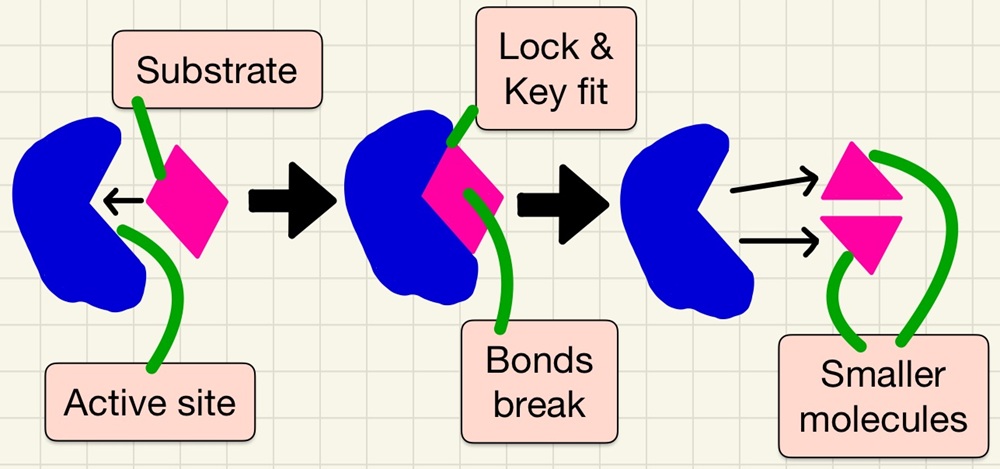Organisation
What we are learning:
Cells, tissues, organs & organ systems:

In the last topic, we learned that there are different types of cells, particularly that there are different types of specialised cells. Tissues are lots of specialised cells working together, an organ is different tissues working together and an organ system has different organs working together. An example of a tissue is a muscle, an organ is a stomach and an organ system is the digestive system.
Human digestive system:

Here you need to know all of the steps of the digestive system and the processes that take place:
• Teeth: Chew food, increase surface area, prevent choking.
• Salivary glands: start breakdown of carbohydrates, lubricate food for swallowing.
• Oesophagus: transport chewed food to the stomach.
• Stomach: hold & churn food in acid & enzymes to break down protein.
• Pancreas: secrete digestive enzymes.
• Bile: emulsify fats and neutralise stomach acid when entering small intestines.
• Small intestines: absorb small molecules - glucose, fatty acids, amino acids.
• Large intestines: absorb water.
• Rectum: store faeces.
• Anus: stop faeces from falling out until you are sat on the toilet.
Enzymes in action:

Enzymes are biological catalysts, they make reactions happen at these temperatures that would not happen without them. We describe their method of working as lock and key because the molecule or substrate will fit into a part of the enzyme or active site and the molecule breaks into smaller molecules. If an enzyme is not in its ideal conditions, for example, it is too hot or in the incorrect pH, it will break and become useless, we call it denatured.
There is a required practical in which we will find optimal enzyme performance.
There are three types of enzymes that are involved in digestion that you need to be aware of
• Carbohydrase: breaks carbohydrates into simple sugars like glucose.
• Protease: breaks proteins down in small amino acids.
• Lipase: breaks lipids into fatty acids and glycerol.
Only these smaller molecules can be absorbed through the walls of your small intestines. There is a second required practical in which you will test different foods to see if they contain lipids, carbohydrates and/or proteins.
The circulatory system:

Our hearts are double pump, they pump blood to our lungs in one half and to the rest of the body in the other half. Fish have a single pump heart. The four vessels attached to our hearts are:
• Pulmonary artery: takes deoxygenated blood from the heart to the lungs.
• Pulmonary vein: takes oxygenated blood from the lungs to the heart.
• Aorta: takes oxygenated blood from the heart to the rest of the body.
• Vena cava: brings deoxygenated blood back from the body to the heart.
When the right side of year heart pumps blood to and from the lungs in the pulmonary artery/vein, it is for gas exchange. Carbon dioxide is sent back to the lungs to breathe out and oxygen is absorbed into your blood. The lungs are specially adapted for this because the alveoli (or each alveolus) have a huge surface area and the capillaries surrounding them are only one cell think to maximise diffusion of gases across them.
Finally, you need to understand the differences between the three types of blood vessels:
• Arteries: Thick muscular walls, high pressure, take oxygenated blood from the heart.
• Capillaries: very thin to allow for exchange to happen efficiently, surround cells and organs.
• Veins: return deoxygenated blood back to the heart, low pressure so are thin but have valves to prevent blood from pooling in your feet.
Important note: there is a simple exception, the only artery to contain deoxygenated blood is the pulmonary artery and the only vein to contain oxygenated blood is the pulmonary vein.
Blood:

Although I still find it strange to describe it this way, blood is a tissue. It is made up of a variety of substances that all have an essential role.
• Red blood cells: These cells use haemoglobin to carry oxygen around the body. They are round to avoid getting stuck and they have no nucleus to give more room for oxygen.
• White blood cells: there are different types all with the same job of fighting infection that has managed to enter the body.
• Platelets: these are cell fragments that clot the blood and form scabs on the skin.
• Plasma: this is the fluid that carries all of the above as well as chemicals like proteins and carbon dioxide on its way from cells to the lungs.
Coronary heart disease:

The coronary artery is the vessel that delivers oxygenated blood to the heart. Remember that the heart is a muscle and without enough oxygen, it will not work properly and parts of it could even die. If there is a build up of fatty material in the artery, it will restrict blood flow, if it restricts it enough then it may cause a cardiac arrest or heart attack.
There are many treatments for this including statins which lower the levels of cholesterol in our blood, stents which widen the artery to increase blood flow and improved diet as a preventative method.
Non-communicable diseases:

Non-communicable diseases cannot be passed onto another person, they are not infectious like a cold or chicken pox. These can be caused by your lifestyle by factors including poor diet, smoking, alcohol consumption, stress and a lack of exercise. Obesity and poor diet can lead to type-2 diabetes.
Having these diseases can have a follow on effect of lowering your immunity levels which make it easier to catch viral infections. Having chronic conditions or several conditions can have a negative effect on a person's mental health. Physical illness can cause depression. Immune reactions can cause allergies such as eczema, hay fever, dermatitis and allergies to pet hair.
Cancer:

Cancers are also referred to a malignant tumours. These are caused when a cell undergoes mitosis at an uncontrolled rate and it grows rapidly. These tumours often invade and conquer adjacent tissues but they can also fragment and they get carried around the circulatory system and begin growing in a new location, this is when we refer to cancer as spreading and it causes secondary tumours.
Plant tissues & organs:

Although it might seem a little mor abstract, plants have organs too. These include the leaf, roots and the stem. The most important part to fully understand is the leaf. The following are the parts from the upper surface then working downwards:
• Waxy cuticle: transparent (to let light in) waxy (to reduce water loss) protective top layer.
• Epidermis: Layer of plant cells, no chloroplasts to remain almost transparent.
• Palisade: Orientated by 90° and full of chloroplasts to maximise photosynthesis.
• spongy mesophyll: lots of gaps to allow gases to diffuse.
• Xylem: delivers water.
• Phloem: delivers nutrients.
• Guard cells & stoma: regulate air flow, will close to reduce excess water loss.
Transport in plants:

Water and dissolved ions are absorbed from the soil by specially adapted root hair cells by osmosis. There is then the transpiration stream which pulls the water and certain dissolved ions from the root hair cells up to the leaves via the xylem. The xylem itself is made of little tubes and relies on capillary action to pull the water up its length, although mainly hollow, it gains strength from the presence of lignin. Sugars that are produced during photosynthesis are transported to other parts of the plant along the phloem in a process called translocation. The cells within the phloem have adapted to have pores in the end wall to allow for the movement of cell sap.
As we mentioned in a previous topic, if you need to move a substance against the concentration gradient, it is called active transport and this process needs energy from respiration.
Key words/terms for this topic
Active site Alveoli Antibody Antitoxin Aorta Artery Atrium Bronchi Bronchiole Capillary Carbohydrate Cardiac Catalyse Cell Coronary Denatured Deoxygenated Double circulatory system Enzyme Epidermal Gland Guard cells Humidity Intestine Lipase Lipid Liver Mesophyll Optimum Organ Organ system Oxygenated Pancreas pH Phloem Photosynthesis Plasma Platelet Protease Protein Pulmonary Stomach Stomata Substrate Temperature Tissue Translocation Transpiration Valve Vein Vena cava Ventricle Villi Wind speed Xylem
Curriculum Health Check:
Q: Why are enzymes described as specific (lock and key)?
A: Enzymes only work in one part of the body and need to stay in that specific location
B: Enzymes only work on a specific molecule
C: Enzymes can only be used once
D: Enzymes only work at a specific temperature
What you need to know
Organ systems are made up of organs working together, organs are made from different tissues working together and tissues are made of cells working together.

Be familiar with the human digestive system, this is an example of an organ system. Link to enzymes and metabolism. Ensure that you can describe enzyme activity and differing pH and temperature and how they catalyse reactions. Lock and key theory, the roles of carbohydrase, protease and lipase are needed including simple word equations. Include the role of bile.

Required practical 3: Use reagents to test for a range of different carbohydrates, lipids and proteins. (Food testing)

Describe the heart, its role and the structure of arteries, veins and capillaries and how they are suited to their role. List the components of blood and describe the job of each part, ensure that you can recognise different parts by image.

Non-communicable diseases (ones that cannot be caught) such as coronary heart disease. The effect of the build up of fatty material in the coronary arteries needs to be known as well as ways of preventing it and what the health problems are that it an cause.

Understand the effect on our health of both communicable and non-communicable diseases, you should be able to use data, such as graphs, to translate effects over time. What puts us at greater health risk such as smoking, alcohol, lack of exercise and how this affects us, the local community, the country or even a world wide issue. Cancer is the last part of disease, causes, treatments and ways to reduce the likelihood of developing certain cancers.

The last part is the plant systems. You need to understand how plant cells form tissues and organs and how they work together. The structure of the leaf optimises photosynthesis while root hair cells work with xylem and phloem to bring the needed water and nutrients to the palisade cells. You should be able to describe optimum conditions for photosynthesis.

This page was updated on: 12th April 2024

